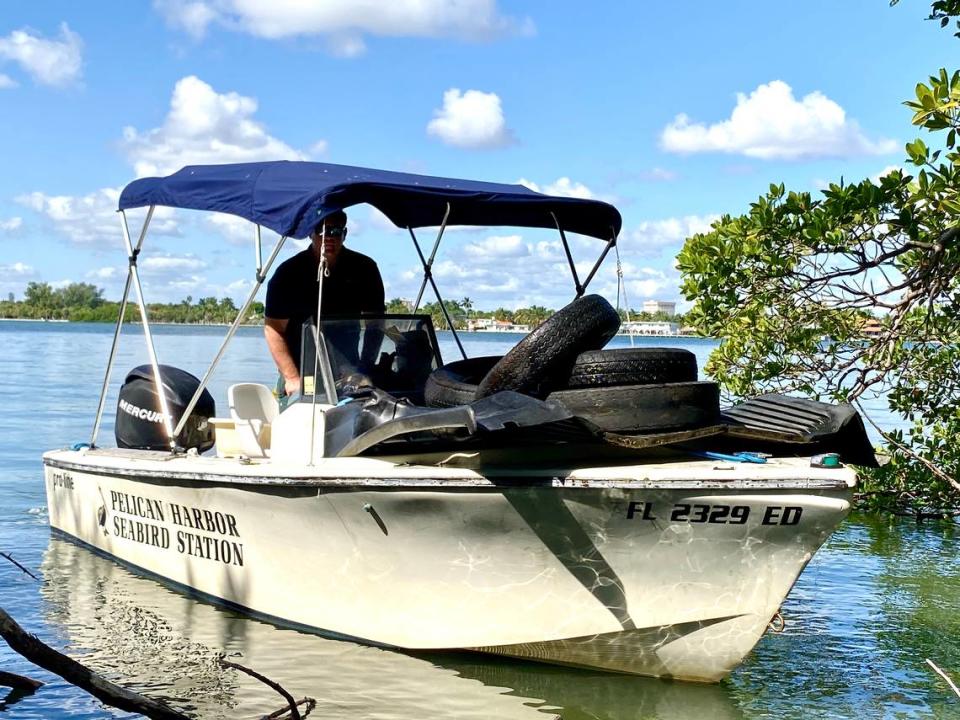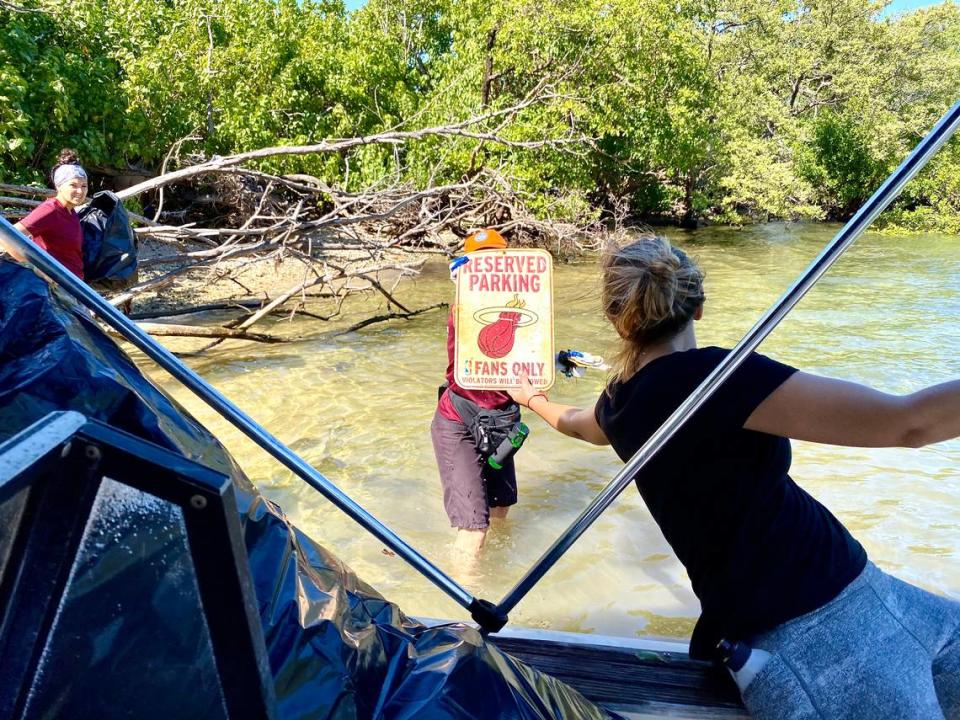Bird Key, a trash-tarnished rookery in Biscayne Bay with a regal past, finally shines again
White sand beneath your feet. Clear water lapping at the shore. Cool shade under the buttonwood trees. You’ve landed on Bird Key, Biscayne Bay’s oldest deserted island, where tropical birds chatter loudly in the treetops and piles of trash have, for decades, been the clearest reminder that you’re still in urban Miami.
This month, the tide finally turned for this nearly seven-acre sliver of sullied paradise, which sits just south of the 79th Street Causeway in Biscayne Bay.
Twenty-five volunteers picked up and hauled away 1.4 tons of tires, patio furniture, cans, bottles, crates, coolers, and myriad other debris that has been washing up on the island since at least the 1980s.
“This is all about the birds and getting plastics out of their nesting rookery,” says Christopher Boykin, who organized the cleanup.
Boykin is executive director of Pelican Harbor Seabird Station, a non-profit wildlife rehabilitation facility in North Bay Village. It has rescued nearly 33,000 birds, and other animals, since its founding in 1980. Many of his avian patients nest on Bird Key, a 10-minute boat ride from the station headquarters.
Boykin has found birds on the island choking on garbage and ensnared in debris. He and others have wanted to clean Bird Key for years, but its unique history, ecological sensitivity, and unusual legal status have made that surprisingly difficult.

Bird Key is one of only two natural islands in Biscayne Bay north of Virginia Key. Some 20 other uninhabited islands are man-made. They were created from material dredged from the bay bottom in the early 20th century when engineers carved out boating lanes. Those “spoil” islands are now recreation areas for boaters and habitats for native trees and shrubs.
Only Bird Key, however, attracts birds in large numbers. Drawn there by instinct, the island serves as a rookery for more than thirty avian species, including brown pelicans, double-breasted cormorants, herons, and egrets. Nearly three acres of dredged material was added to the north end of the island in the early 1900s, expanding the rookery and creating the largest remaining bird-watching spot in Miami. Meanwhile, 31 acres of endangered sea grass surround the island, making it an important marine habitat for lobsters, sea turtles, and manatees.
For decades, the island eluded writers and historians, its history locked away in library microfiche and out-of-print books. But, in 2012, the Miami Herald published a feature on Bird Key recounting its storied past and noting that, “A surveyor sent by King George III to the British province of East Florida marked the spot on his map of Biscayne Bay in 1770. He called it Bird Island, a name that affirms its historic importance as a rookery.”
Through a series of unlikely later events — involving a 19th century poker game, the Mexican-American War, and a Miami con man — the island eventually fell into the hands of Charles Deering, the wealthy industrialist whose former South Miami estate is now a popular attraction.
Then, in 1985, local real-estate investors Edward Easton and Finlay Matheson acquired Bird Key for $36,000. They still own it today, making Bird Key the only privately-owned, unoccupied island in the bay.

Matheson, who is the grandson of renowned Miami pioneer William J. Matheson, told the Herald in 2012 that he bought the island because he “just thought it was kind of fun to have an island in the middle of Biscayne Bay.”
Private ownership has meant that Bird Key has never benefited from regular county cleanups that happen on the government-owned spoil islands. Consequently, for the last 34 years, corresponding to Miami’s population boom and a steep increase in plastic consumption, the island has slowly accumulated debris flushed into the bay from canals, blown in by storms, or left behind by trespassers.
In 2012, Matheson told the Herald he had always wanted to clean the island but was “hampered by the difficulty of mooring a big enough boat nearby to transport the trash.” He said a cleanup crew would also spook nesting birds and noted that the trash served the useful function of discouraging trespassers who would further disturb the wildlife. He hoped to see the island acquired by a government agency or private group that would restore it and declare it a protected bird sanctuary.
For decades, in fact, Bird Key has been on Miami-Dade County’s Environmentally Endangered Lands list, which identifies sites for potential public acquisition and conservation. Even as far back as 1986, a report by the Florida Department of Environmental Regulation declared that “Bird Key should be purchased by the State of Florida or other public entity.”
Matheson, however, says he has had no offers from any government agency in the 34 years that he has owned the island.
Such public protection would be invaluable, especially considering Bird Key’s unusual legal status. The island lies just inside Miami’s borders and, surprisingly, is zoned residential. In the current era of hyper-development, that has raised an important question: If the island is sold, is there anything to prevent a new owner from building on what would surely be Miami’s most exclusive address?
Miami’s Planning and Zoning Department didn’t respond by press time to inquiries about potential construction on Bird Key. But Tere Florin, a spokeswoman for Miami-Dade County’s office of Regulatory and Economic Resources, says the county would play a role in any request to build on Bird Key.
“It’s difficult to comment on what could be built without an application to review,” Florin says, “but the county would be involved in reviewing an application for development through its environmental regulatory authority [as it applies to] wetlands, mangroves, water and wastewater.”
She adds that the Department of Environmental Resources Management has the authority to deny the issuance of municipal building permits if a project doesn’t comply with the county’s environmental requirements.
Matheson, meanwhile, says he has made no effort to solicit offers for his island and, in 2012, agreed to allow Brian Fox, the former executive director of Pelican Harbor Seabird Station, to organize a cleanup of Bird Key. Fox, however, abruptly departed the organization before he could see it through.

Last year, Boykin picked up where Fox left off. With Matheson’s blessing, he and 17 volunteers removed 1,850 pounds of trash from Bird Key. This year, on Veterans Day on Nov. 11, Boykin returned with 25 volunteers to collect the rest, hauling away another 2,700 pounds of debris.
Boykin, however, says trash isn’t Bird Key’s only challenge. Invasive iguanas have recently proliferated on the island, scaring away nesting birds. Non-native trees like Australian pines and Brazilian peppers, meanwhile, are beginning to crowd out the mangroves and buttonwoods where birds nest. And trespassers have hung swings from trees, blasted music, set up lean-to shelters, and left tree trunks full of hypodermic needles.
Boykin wants to address those problems by erecting “No Trespassing” signs and partnering with the Florida Fish and Wildlife Conservation Commission and other community groups. He also hopes to do an annual cleanup on the island.
“Bird Key is just such a special, magical place,” he says. “In a megalopolis like Miami, with so much concrete and population, to have this biodiversity and wealth of life is an incredible thing.”
Terence Cantarella, t.cantarella@gmail.com, is a writer living in Miami. He wrote this story for the Miami Herald.

